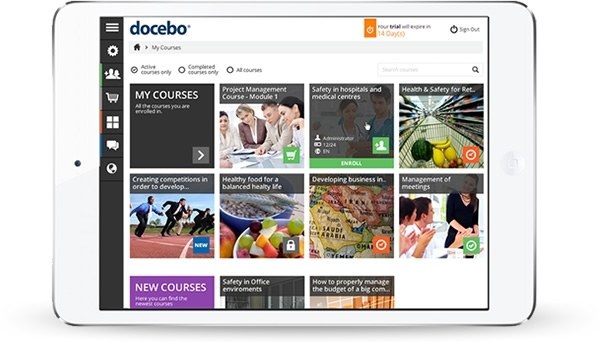The 8 Essential Elements Of A Synergistic eLearning Strategy
A synergistic eLearning strategy might sound like a daunting prospect, but it doesn’t have to be. It’s about looking at eLearning as a whole, not in parts. Instead of tackling online training, social learning, microlearning, mobile and the rest as individual tasks, think of a tandem eLearning approach. Bring appropriate eLearning tools into that approach to create an immersive eLearning experience. Consider your online learners: their background, goals, behaviors, learning preferences. Design a learning approach that blends online with in person; games and branching scenarios with on-the-job skills development. Combine a person-centered approach with the right technology and setting.
What Is A Synergistic Strategy?
Synergy is about the creation of a whole that is greater than the simple sum of its parts. If we consider this in the world of eLearning, it’s about creating an experience that embeds learning and transforms behaviors. The goal isn’t to produce a piece of training, deliver it, and move on to the next learning objective. Thus, we need to start with adjusting the context to the training need and examine the needs we are looking to fulfill. eLearning alone may not provide the kind of immersive experience that we are looking for. There may well be a need to bring people together to discuss and share opinions.
We might need to provide further eLearning resources or opportunities to ask questions. This is what synergy is all about: building a learning approach that addresses real, specific training needs. Combining the appropriate elements to create an all-encompassing learning path. Learning isn’t about acquiring new information. It’s about living and breathing new ideas; getting a chance to test them out and try new things.
Essential Elements Of Synergistic Learning Design
To help narrow down the options, it’s worth considering several essential elements of a comprehensive synergistic eLearning strategy. In fact, you may need to tweak your eLearning strategy by focusing on several of these, and even bringing in new ideas.
1. Learning Technology
Choose your eLearning development tools with immersive technology in mind. Allow for a broad range of Instructional Design approaches to appeal to all online learners. Lean on online training wherever learners are dispersed, or time-poor. The benefits in cost savings and increased adoption are well proven. The toolbox staples include eLearning authoring tools, LMSs, and video conferencing software.
2. Scheduled Face-To-Face Or Online Synchronous Sessions
Do you need to bring online learners together? If possible, why not schedule an online workshop using your collaboration platform. Or, if you have people coming together (a conference, for example), why not take the opportunity for a shared eLearning experience. Feeling more connected to other online learners is a powerful engagement technique. In the framework of a synergistic eLearning strategy, you can also host regular live events that give online learners the ability to interact and share their experiences.
3. Mobile Learning
Ensure you design with responsive capability in mind. Allow your online learners to participate wherever and whenever they choose, using their own device if they wish. Ensure that mobile learning activities give online learners control of the audio playback and feature images optimized for the small screen.
4. Microlearning
Consider breaking modules into microlearning online training assets, that you can release alongside other eLearning materials. Short bursts of visual, impactful training, create a sense of fun and anticipation in online learners. In fact, you may want to launch a bite-sized repository that offers online learners "moment of need" support.
5. Interactive Design Features
Provide a range of design elements, where appropriate. Lean on visuals, games, and simulations to ensure a rich eLearning experience. Branching scenarios are another great way to create a sense of immersion and make online learners aware of the real-world consequences of their actions.
6. Social Learning
A synergistic eLearning strategy should give online learners the opportunity to connect and learn from each other. For example, create discussion groups such as eLearning blogs, online discussions, social platforms, group or individual chat tools. But don’t forget the real-life interactions: virtual lunch and learn sessions, Q&A with Subject Matter Experts all enrich the learning. Another option is to incorporate team collaboration activities that allow them to solve problems and hone interpersonal skills in a group setting.
7. Coaching And Mentoring
Focus on the importance of continuous learning with a mentoring program as a part of your synergistic eLearning strategy. Set up connections wherever possible to link online learners and experts. Don’t forget to develop guidelines and/or training contracts so that everyone knows what to expect and which online resources are available. For example, it should feature milestones and long-term goals that keep the duo on track and maintain the motivation.
8. On-The-Job Performance Support Systems
Nothing compares to learning on the job. However, you need to give your people the right support so that when things go wrong, it feels like positive eLearning feedback rather than negative criticism. You should also give online learners the ability to identify personal gaps through assessments. Even something as simple as a pop quiz before the eLearning course can help them pinpoint areas for improvement and improve performance behaviors.
Once you have understood the concept of a synergistic eLearning strategy, it’s difficult to consider any other approach. It’s about retraining L&D strategy towards what you want to deliver and why, rather than how you want to train your people. Providing options that are inclusive of different learning preferences is more important than ever. Start by taking a step back to consider the organization learning goals. How will you embed consistent values and skills across different working streams? Which learning approaches are most important to your workforce?
Conclusion
Synergy is about creating an eLearning environment that is fluid, responsive and inclusive. So, stop focusing on design features and technical possibilities. Instead, think about what your online learners need to do to change. How can you support them and foster a culture of learning for change, for improvement, for development? A synergistic eLearning strategy is about combining the best eLearning approaches to provide a personal eLearning experience for your people.
How exactly do you plan a successful eLearning project from day one? Download our free eBook Top Tips To eLearning Project Management And Planning to discover the characteristics of a successful eLearning team and how to improve online collaboration in eLearning projects, how to select the proper Project Management platform, how to start planning, determine goals, and pick up the most suitable ID Model for your eLearning project.









